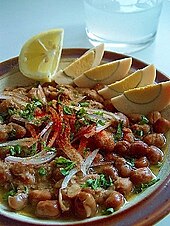
Comfort food is food that provides a nostalgic or sentimental value to someone[1] and may be characterized by its high caloric nature associated with childhood or home cooking.[2] The nostalgia may be specific to an individual or it may apply to a specific culture.[3]
The term comfort food has been traced back at least to 1966, when the Palm Beach Post used it in a story: "Adults, when under severe emotional stress, turn to what could be called 'comfort food'—food associated with the security of childhood, like mother's poached egg or famous chicken soup."[4] According to research by April White at JSTOR, it might have been Liza Minnelli who used the term for the first time in its modern meaning in an interview, admitting to craving a hamburger.[5]
When the term first appeared, newspapers used it in quotation marks. In the 1970s, the most popular comfort food in the United States were various potato dishes and chicken soup, but even at the time, the definition varied from person to person. During the next decades, the nature of comfort food changed in the USA, shifting from savory dishes to sweet ones, while comfort food themed cookbooks started to spread and restaurants started to offer items labelled as such, when originally the term was used for food items consumed "home alone". Worldwide diet trends, emerging in the 1990s, like the low fat or the low-carb diet were unable to end the cravings for comfort food. According to White, the COVID-19 pandemic that hit the world in 2020 further strengthened people's need for comfort food that evokes nostalgia and the feeling of belonging.[5]
Consuming energy-dense, high calorie, high fat, salt or sugar foods, such as ice cream or french fries, may trigger the reward system in the human brain, which gives a distinctive pleasure or temporary sense of emotional elevation and relaxation.[6][7] These feelings can also be induced by psychoactive ingredients found in other foods, such as coffee and chocolate.[8] When psychological conditions are present, people often use comfort food to treat themselves. Those with negative emotions tend to eat unhealthy food in an effort to experience the instant gratification that comes with it, even if only short-lived.[9]
One study divided college-students' comfort-food identifications into four categories (nostalgic foods, indulgence foods, convenience foods, and physical comfort foods) with a special emphasis on the deliberate selection of particular foods to modify mood or affect, and indications that the medical-therapeutic use of particular foods may ultimately be a matter of mood-alteration.[10]
The identification of particular items as comfort food may be idiosyncratic, though patterns are detectable. In one study of American preferences, "males preferred warm, hearty, meal-related comfort foods (such as steak, casseroles, and soup) while females instead preferred comfort foods that were more snack related (such as chocolate and ice cream). In addition, younger people preferred more snack-related comfort foods compared to those over 55 years of age." The study also revealed strong connections between consumption of comfort foods and feelings of guilt.[11]
Comfort food consumption is seen as a response to emotional stress and, consequently, as a key contributor to the epidemic of obesity in the United States.[12] The provocation of specific hormonal responses leading selectively to increases in abdominal fat is seen as a form of self-medication.[13]
Further studies suggest that consumption of comfort food is triggered in men by positive emotions, and by negative ones in women.[14] The stress effect is particularly pronounced among college-aged women, with only 33% reporting healthy eating choices during times of emotional stress.[15] For women specifically, these psychological patterns may be maladaptive.[16]
A therapeutic use of these findings includes offering comfort foods or "happy hour" beverages to anorectic geriatric patients whose health and quality of life otherwise decreases with reduced oral intake.[17]
A partial list by region of comfort foods around the world.
|
Main article: Afghan cuisine |
Comfort foods in Afghanistan are:
|
Main articles: Australian cuisine, New Zealand cuisine, and South African cuisine |

Comfort foods in Australia, New Zealand and South Africa may include:
|
Main article: Brazilian cuisine |

|
Main article: Canadian cuisine |

|
Main article: Egyptian cuisine |


|
Main article: French cuisine |
|
Main article: German cuisine |

German comfort foods may include the following foods:
|
Main article: Greek cuisine |
|
Main article: Hong Kong cuisine |
|
Main article: Hungarian cuisine |

|
Main article: Indian cuisine |
|
Main article: Indonesian cuisine |

Some popular Indonesian foods are considered to be comfort food, usually served hot or warm, and either soupy or with a soft texture. Most of them are high in carbs or fat, such as congee, fried rice, and noodles which are high in carbs; while meatballs and grilled skewered meats contain fair amounts of fat and salt. Comfort foods often are the kind of food that provides nostalgic sentiments, as they often called masakan rumahan (home cooking) or masakan ibu (mother's dishes). In Indonesia, the warm and soft texture of bubur ayam is believed to help people to recover during convalescence.[76] Sayur sop or sup ayam is Indonesian chicken soup that often sought during flu. The warm soup contains chunk of chicken, bits of potato, carrot, and common green bean served in chicken stock.[77]
Some Indonesian comfort foods are traditional Indonesian food and some are derived from Chinese influences.
Indonesian comfort foods include:
For some Indonesians, especially those who are abroad, comfort food may include a favourite brand or type of Indonesian instant noodles, such as Indomie Mi goreng mentioned already.[82]
|
Main article: Irish cuisine |
|
Main article: Italian cuisine |

|
Main article: Japanese cuisine |
In Japan, there is an expression called "Taste of Mom(おふくろの味)".
|
Main article: Filipino cuisine |

|
Main article: Polish cuisine |

Some Polish comfort food include:

Some Puerto Rican comfort foods include:
|
Main article: Romanian cuisine |

Romanian comfort foods may include:
|
Main article: Russian cuisine |

Russian comfort foods may include:
|
Main article: Korean cuisine |

|
Main article: Spanish cuisine |

|
Main article: Catalan cuisine |
Comfort foods in Catalonia include:
|
Main article: Swiss cuisine |

Traditional Swiss cuisine is characterized by its simplicity and extensive use of dairy products like cheese, cream and butter. Fruits (often apple compote) are also used in many (main) dishes,[143] notably Älplermagronen and Maluns.

|
Main articles: Chinese cuisine and Taiwanese cuisine |

|
Main article: Turkish cuisine |
Some Turkish comfort foods are:
|
Main article: Ukrainian cuisine |
Ukrainian comfort foods include, but aren't limitied to:
|
Main articles: British cuisine, English cuisine, Scottish cuisine, Welsh cuisine, Northern Irish cuisine, and Cornish cuisine |

United Kingdom comfort foods include:
|
Main article: American cuisine |

American comfort foods may include the following foods: